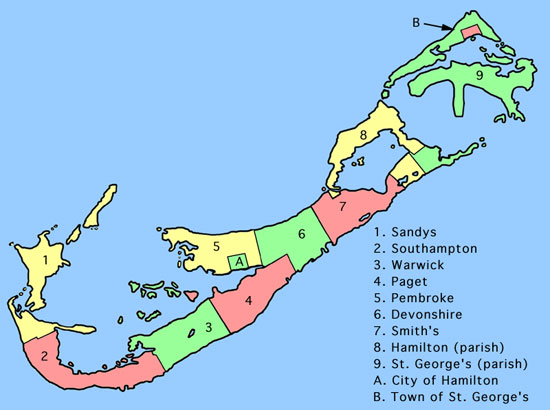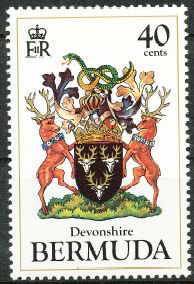Tribe: a social division of people defined by a common characteristic
Early on in the colonial history Bermuda was divided into tribes which were further subdivided into shares. The painstaking work that this entailed fell to Richard Norwood, a teacher from England. Each tribe was 1,250 acres and each share was 25 acres – the divisions in straight lines across from North shore to South shore making plots of land of varying width but crucially each with access to a portion of coast. There were 8 tribes divided in this way, with St George’s and several other discrete islands remaining as company land. The tribe was then named after the Adventurer who had purchased most share within that tribe.
Thus the tribes were named:
- Sandys – Sir Edwyn Sandys
- Southampton – Henry Wrothesley, Earl of Southampton
- Mansil’s – Robert Mansell aka Mansfleid (who later sold his shares to Earl of Warwick)
- Paget – William Paget, Fourth Lord Paget
- Pembroke – William Herbert, Third Earl of Pembroke
- Cavendish – William Cavendish who became First Earl of Devonshire
- Smith’s – Sir Thomas Smith
- Bedford’s – Lady Lucy Harrington, Countess of Bedford (later sold to James Hamilton)
They were referred to as Tribes up to 1684, presumably as churches were established within them. The remnants of the earlier naming is seen in the multiple “Tribe Roads” that dissect the island perpendicular to the long roads. To call them roads is somewhat ambitious – some only wide enough to roll a barrel.
I have focussed first on Devonshire because that’s where I am living.
William Cavendish is, I have discovered, a common name – the one in question was born 1552 and died 1626 and was the First Earl of Devonshire, but research is complicated by unimaginative naming of children, all William, with the occasional Henry thrown in randomly.
William Cavendish must have had a large extended family – his father had three wives and his Mother married four times, dissatisfaction as much as death prompting the changes. Anyhow, he was the second son of (predictably) William Cavendish and Bess of Hardwick. Second son? Yes, Henry was an embarrassment to his Mother who disowned him so William became her favourite.
Some of my English readers will recognise the “Devonshire ” and correctly link him to Chatsworth House (in Derbyshire, just to confuse everyone). This now enormous estate was originally purchased by William’s father for £600; his money came from land he had amassed in his name during the dissolution of the monasteries – he was Privy Councillor and Treasurer to Henry VIII. Sadly William the elder lived only long enough to conceive three sons and spend just five years owning Chatsworth – maybe three wives is not such a good idea. So at the age of 5, our William was left fatherless, with two not-so-very-nice stepfathers to come.
He was educated at Eton, Cambridge and Gray’s Inn. He didn’t inherit his vast estates until he was 56 when his mother died leaving him four impressive estates in the English Midlands. William was a Member of Parliament for two years – first for Liverpool (1586) and then for Newport, Cornwall (1587). It might seem odd that he represented areas so far from his family home, but explained by the acrimonious relationship with his stepfather George Talbot, Earl of Shrewsbury. In 1605 William became Baron Cavendish, step one on the ladder to peerage. Debrett’s informs that he advanced to the dignity of Earl of Devonshire in 1618.
William married Anne Keighley, a fecund lady who gave birth to 6 children in 8 years; of course they named the eldest William. They hired Thomas Hobbes, later philosopher, as tutor to the young boy, a relationship lasting over 20 years and enabling Hobbes himself to invest in The Somers Island Company. Inevitably this new William became Earl of Devonshire and so on almost ad infinitum (current incumbent is called Peregrine, and it’s a Dukedom now)
All that is preamble to explaining how he managed to own 10 shares of land in the parish of (now) Devonshire. fellow parishioners included Pennistone, Dike, Barnard, West, Lukin, Ditchfield, Nicholls, Fletcher, Delaune, Roger, Palmer and Rich. Of course, it is unlikely that many if any of them actually came to Bermuda, preferring absentee landlord status – the rules are tighter these days.
It has been hard to find anything pertaining to the character of William Cavendish. One small extract from “History of The Virginia Company” by Edward Duffield Neill describes how Cavendish quarrelled with Earl of Warwick, each calling the other a liar over a matter not detailed. It is said that he challenged Warwick to a duel and that the Privy Council subsequently blocked the ports of England to prevent them reaching the continent (were duels perhaps banned in England ?) Cavendish was apprehended at Shoreham, Essex , but Warwick reached Ghent. The whole incident contributed to the Virginia Company Charter being declared null and void in 1624. It is said that their wives remained friends throughout.
Devonshire has for its coat of arms that of the Cavendish Family.
Sable (black) shield
3 stags heads caboshed (cut of behind the ears)
coronet of an Earl – silver balls on points with gold strawberry leaves between
Cavendish green serpent
2 rampant stag supporters
This is the sign along South Road approaching Devonshire from Smiths (needs a soapy brush)



